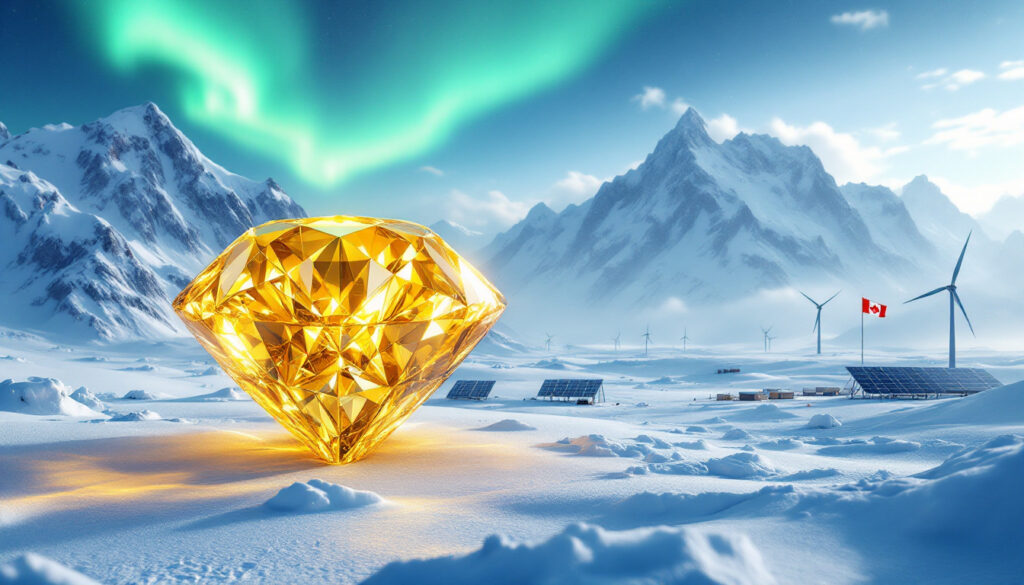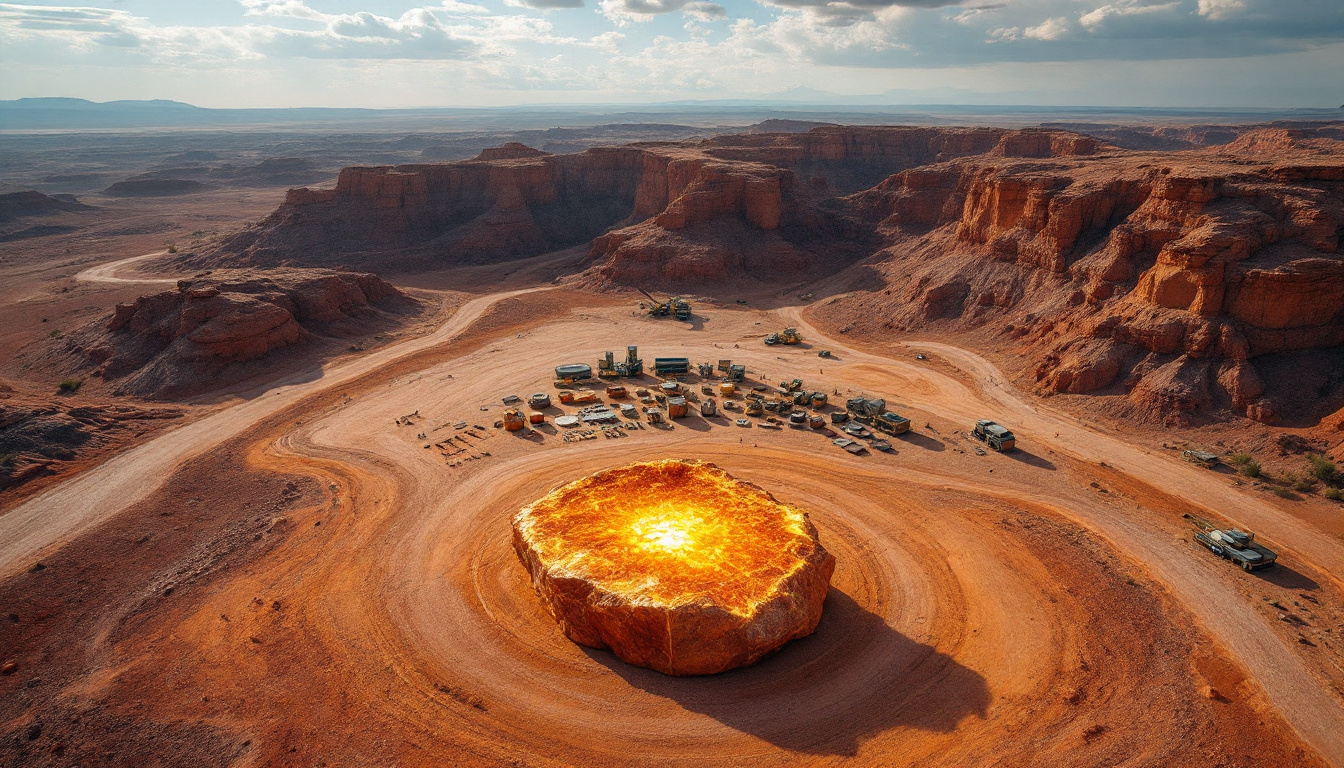Rio Tinto's 'Exceptional' Diamond Discovery: A Rare Gem from the Arctic
Rio Tinto has uncovered an extraordinary yellow diamond weighing 158.20 carats at its Diavik Diamond mine in Canada's Northwest Territories. This remarkable find represents a significant moment in mining history, showcasing both the natural wonders hidden beneath the Arctic landscape and Rio Tinto's bold shift towards clean energy investments in challenging environments.
What Makes This Diamond Discovery Special?
The recently discovered 158.20-carat rough yellow diamond from Rio Tinto's Diavik mine is truly exceptional in several ways. Yellow diamonds are incredibly rare, constituting less than one percent of Diavik's total production, which primarily yields high-quality white diamonds. This discovery marks only the fifth yellow diamond weighing over 100 carats ever found at Diavik throughout its 22-year operational history.
The geological conditions required to form colored diamonds make them especially precious. Yellow diamonds get their distinctive hue from nitrogen atoms replacing carbon in the crystal structure during formation over two billion years ago. This particular specimen's combination of size, color, and quality places it among the most significant diamond discoveries in recent years.
Matt Breen, Diavik Diamond Mines Chief Operating Officer, described the discovery as "a miracle of nature and testament to the skill and fortitude of all the men and women who work in Diavik's challenging sub-arctic environment." This statement underscores not only the diamond's natural rarity but also the exceptional human effort required to recover such treasures.
Where Was This Exceptional Diamond Found?
The Remote Arctic Location of Diavik Mine
The Diavik Diamond mine operates in one of the world's most challenging mining environments, located approximately 200km south of the Arctic Circle in Canada's Northwest Territories. This remote location experiences extreme weather conditions, with winter temperatures regularly dropping below -40°C, requiring specialized equipment and mining techniques.
The mine sits on an island within Lac de Gras, a pristine Arctic lake, adding further complexity to operations. During winter, the frozen lake surface serves as an ice road for transporting supplies and equipment, while summer months require air transport or barge operations during the brief ice-free period.
The diamonds at Diavik formed over two billion years ago under intense pressure and heat deep within Earth's mantle. Volcanic eruptions later brought these diamonds closer to the surface through kimberlite pipes—vertical geological structures that serve as natural diamond delivery systems from the depths.
Diavik's Mining History and Production Profile
Since beginning operations in 2003, the Diavik mine has established itself as a premier producer of high-quality diamonds. The mine has processed approximately 57 million tonnes of ore throughout its operational lifetime, yielding exceptionally pure stones that command premium prices in international markets.
The mine initially operated as an open-pit operation but transitioned to underground mining in 2012 to access deeper diamond deposits. This technical achievement represents significant engineering expertise, especially considering the mine's location in permafrost conditions and complete isolation from established infrastructure.
How Does Rio Tinto Ensure Sustainable Diamond Mining?
Renewable Energy Initiatives at Diavik
Despite operating completely off-grid in one of Earth's harshest environments, the Diavik mine demonstrates remarkable commitment to decarbonisation in mining through innovative energy solutions:
- Since 2012, the operation has utilized a hybrid wind-diesel power facility, with wind turbines specifically engineered to withstand Arctic conditions
- The 9MW wind farm has significantly reduced diesel consumption, displacing approximately 30 million liters of diesel fuel since implementation
- In 2024, Rio Tinto completed construction of a solar power plant at the site, further reducing the mine's carbon footprint
- The combined renewable energy initiatives now reduce diesel dependency by approximately 40%, an impressive achievement for a remote Arctic operation
These sustainability measures showcase Rio Tinto's leadership in implementing renewable energy solutions in challenging environments, setting new standards for responsible resource development in sensitive ecosystems.
Responsible Sourcing Commitments
Beyond environmental initiatives, Diavik maintains strict responsible sourcing practices. The mine participates in certification programs ensuring diamonds are ethically produced, conflict-free, and fully traceable from mine to market.
Patrick Coppens, Rio Tinto's diamonds business general manager of sales and marketing, highlighted the significance of Diavik's production, noting that "The beauty and purity of Diavik diamonds continues to excite passions amongst all who see them." This reflects both the exceptional quality of the gems and the ethical standards maintained throughout the production process.
The mine also maintains strong relationships with local Indigenous communities, with partnerships that include employment opportunities, business development, and environmental stewardship programs that respect traditional land use practices.
What Other Developments is Rio Tinto Pursuing?
Educational Initiatives to Address Mining Skills Shortages
Recognizing the global challenge of mining workforce development, Rio Tinto has recently partnered with the University of Queensland (UQ) to establish the South Gobi Underground Mass Mining Institute in Mongolia. This forward-thinking initiative directly addresses the concerning decline in students pursuing mining engineering degrees worldwide.
The institute will provide comprehensive training to both local and international mining professionals, combining academic education with practical hands-on experience. Rio Tinto's Oyu Tolgoi copper mine, representing a $3 billion investment in copper expansion, will serve as the primary training hub for the inaugural 2025 cohort.
This educational partnership demonstrates Rio Tinto's commitment to addressing ESG challenges and global opportunities in mining beyond immediate resource extraction. By building mining expertise in developing regions, the company helps create pathways to economic development while addressing its own future workforce needs.
The Significance of Yellow Diamonds in Today's Market
Yellow diamonds have gained increasing prominence in the luxury jewelry market in recent years. Their warm, sunny hue provides a distinctive alternative to traditional colorless diamonds, with leading jewelry designers incorporating these rare yellow diamonds into signature pieces for discerning clients.
The discovery of a 158.20-carat yellow diamond represents significant potential value. Once cut and polished, this rough stone could yield multiple finished diamonds of exceptional quality, potentially including a center stone of extraordinary size and brilliance.
As with all rare colored diamonds, the value of yellow diamonds has increased significantly following the 2020 closure of Australia's Argyle mine, which had been responsible for approximately 90% of the world's pink diamonds and a significant portion of yellow diamond production. With this major source no longer operational, exceptional yellow diamonds like the Diavik discovery become even more valuable.
FAQ About Rio Tinto's Diamond Discovery
How Rare Are Yellow Diamonds of This Size?
Yellow diamonds of this size (over 100 carats) are extraordinarily rare, with this discovery being only the fifth such find in Diavik's 22-year history. Yellow diamonds constitute less than 1% of the mine's total diamond production, making this 158.20-carat specimen truly exceptional.
Globally, only about 0.01% of all diamonds mined are fancy yellow, and most of these are significantly smaller than 100 carats. The geological conditions required to form large, gem-quality yellow diamonds occur in very few locations worldwide, making each discovery a significant event in the diamond industry.
What Makes This Diamond "Exceptional"?
This diamond earns its "exceptional" designation through several distinguishing characteristics:
- Its substantial size (158.20 carats) places it among the largest rough diamonds discovered in recent years
- Its rare yellow color, resulting from specific nitrogen inclusions during formation
- Its gem quality, indicating potential for creating multiple high-value polished stones
- Its discovery location in the remote Canadian Arctic, where mining operations face extreme challenges
Most diamonds recovered worldwide are significantly smaller (often less than one carat) and frequently not gem-quality, making this combination of attributes particularly remarkable.
How Does Diamond Mining Impact Local Environments?
Diamond mining can have significant environmental impacts, including habitat disruption, energy consumption, and water usage. However, operations like Diavik demonstrate how responsible practices can mitigate these effects:
- The mine's hybrid wind-diesel power facility and new solar installation reduce carbon emissions significantly
- Comprehensive water management systems protect the surrounding Lac de Gras watershed
- Detailed closure and reclamation plans ensure the site will be rehabilitated after mining concludes
- Regular environmental monitoring programs track potential impacts on local ecosystems
These sustainability measures showcase how modern mining operations can balance resource extraction with environmental stewardship, even in sensitive Arctic environments.
The Future of Diamond Mining at Rio Tinto
As one of the world's largest mining companies, Rio Tinto continues to balance resource extraction with environmental and social responsibility. The discovery of this exceptional yellow diamond highlights both the potential rewards of investing in mining stocks and the company's ongoing commitment to sustainable practices in challenging environments.
The company's focus on training the next generation of mining professionals through initiatives like the South Gobi Underground Mass Mining Institute demonstrates a long-term vision for responsible resource development. This approach recognizes the crucial role of mining in the clean energy transition and that mining's future depends not only on discovering valuable resources but also on developing the skills and technologies needed for increasingly complex extraction challenges.
As global diamond markets evolve, discoveries like the 158.20-carat yellow diamond reinforce Canada's position as a premier source of high-quality, ethically produced diamonds. Rio Tinto's continued investments in renewable energy, community partnerships, and workforce development ensure that remarkable gems like this will continue to emerge from the Diavik mine in Canada for years to come, bringing beauty to the world while respecting the environments from which they come.
Looking for the Next Diamond in the Rough?
Stay ahead of the market with instant notifications on significant ASX mineral discoveries through Discovery Alert's proprietary Discovery IQ model, turning complex mining data into actionable investment insights. Understand why major mineral discoveries can lead to substantial returns by exploring Discovery Alert's dedicated discoveries page and begin your 30-day free trial today.




